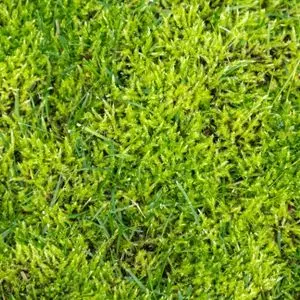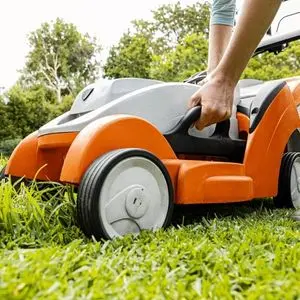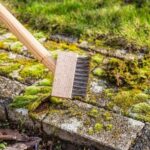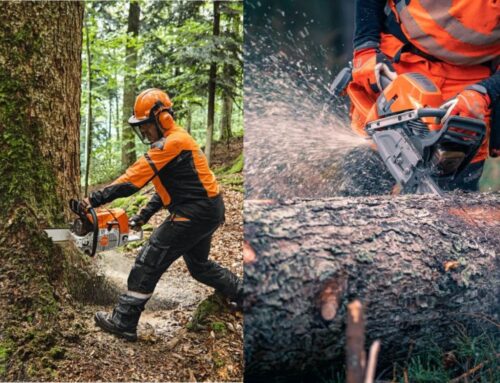
The Best Ways to Get Rid of Moss on a Lawn
Moss divides opinion. To some, it’s a soft, velvety green that looks beautiful in shade and damp corners. To others, it’s a sign their lawn isn’t as healthy as it could be—thin grass, spongy patches, and a look that’s more patchwork than pristine. If you’re in the second camp, we’re now going to reveal how to get rid of moss on a lawn. We’ll explain what lawn moss actually is, when it’s a problem, what causes it, the best way to rid a lawn of moss, what to do with the debris once you’ve cleared it, and how to stop it creeping back.
What Is Lawn Moss?
 Moss is a handy umbrella term for a group of primitive, non-flowering plants that reproduce by spores and anchor themselves with tiny rhizoids rather than true roots. That shallow anchoring is why moss lifts so easily with a rake.
Moss is a handy umbrella term for a group of primitive, non-flowering plants that reproduce by spores and anchor themselves with tiny rhizoids rather than true roots. That shallow anchoring is why moss lifts so easily with a rake.
There isn’t a single lawn moss species—there are many, and a surprising number are happy just about anywhere with enough moisture. Because moss makes its own food through photosynthesis and drinks in water across its surface, it can colonise compacted soil, bare ground, and even stones or thatch.
Is Moss Really a Problem?
Not always. In low-traffic, shaded areas where grass struggles, moss can be a sensible, low-maintenance alternative—it’s soft underfoot, green all year round, and creates habitat for small creatures that, in turn, support birds and hedgehogs. But if you want a more traditional lawn, moss can make surfaces uneven and leave bald patches after dry spells. In family gardens and ornamental lawns, that’s reason enough to aim for effective grass moss control.
If you decide to tackle it, the aim isn’t simply to buy a moss killer for lawns and call it done. The real goal is to make conditions right for grass so moss can’t outcompete it.
What Causes Lawn Moss?
Moss tends to dominate where grass is on the back foot. Common triggers include:
- Compacted soil and poor drainage. Water lingers on the surface, starves roots of air, and creates the permanently damp conditions moss enjoys.
- Shade and low light. Beneath trees, next to fences, or on the north side of buildings, grass thins, and moss slips in.
- Nutrient imbalance and low fertility. Underfed turf grows weakly, leaving gaps in the lawn.
- Cutting too low. Scalped lawns develop bare patches; moss fills them fast.
- Soil pH extremes. Acidic soils (low pH) favour moss; most turf grasses prefer around 6.5–7.0.
- Thatch build-up. A mat of dead material traps moisture and encourages shallow rooting.
Short bursts of wet weather can spark a flare-up too, but persistent moss nearly always points to one or more of the issues above.
How to Remove Moss from a Lawn
There’s no single silver bullet to removing moss, but there is a tried-and-tested sequence of tasks that works well for most gardens.
1) Scarify to Clear What’s There
 Start with physical moss removal from lawn surfaces. When you rake, you’re also lifting thatch, improving airflow, and giving grass blades space to tiller. A lawn/ moss rake is fine for smaller patches. For larger areas, use a dedicated scarifier.
Start with physical moss removal from lawn surfaces. When you rake, you’re also lifting thatch, improving airflow, and giving grass blades space to tiller. A lawn/ moss rake is fine for smaller patches. For larger areas, use a dedicated scarifier.
It’s worth noting that people often use the terms ‘scarifier’ and ‘dethatcher’ interchangeably, but there is a difference. A scarifier (manual or powered) has blades or spring tines that cut into the surface to pull out moss and thatch, slitting the soil in the process. A dethatcher is generally a lighter-touch tool (or a lawnmower attachment) that combs out thatch near the surface. For heavy grass moss removal, a scarifier is the better first step; a dethatcher is useful for routine grooming later.
If you’re aiming to remove moss from lawn UK windows are spring (as growth picks up) and autumn (while soil is warm and moist). Autumn lawn moss treatment pairs scarifying with overseeding and feeding.
2) Aerate to Fix Compaction
Compaction is one of the most common underlying causes of moss. So, use an aerator on heavier soils to remove plugs and open up the surface, then brush in sharp sand or a sand-rich topdressing to create drainage channels. On smaller lawns, a garden fork works fine—spike the area and gently heel back the holes.
3) Consider a Targeted Moss Control Product
You can’t always do the cultural work and wait weeks for results. Sometimes you want to eliminate moss in lawn first, then continue with soil fixes. That’s where certain products can help:
- Bacteria-based (organic) products. These digest moss and often include a gentle feed. The bonus: the dead moss usually crumbles away, reducing raking. If you prefer natural approaches to moss removal from yard lawn, these are a strong choice.
- Iron sulphate products. A classic grass moss killer that blackens moss quickly; you’ll need to rake out the dead material. Combination feeds labelled ‘lawn and moss killer’ or ‘weed and feed and moss killer’ also exist—handy if you want both a fertiliser and a moss in lawn killer.
In terms of the best moss killer for lawns, choose one based on your priorities. Go organic if you’d rather avoid synthetics and extra raking; choose iron if you want fast blackening ahead of a serious scarify. And always follow the label.
Timing Matters
Many organic products need warmth to work well, while iron-based products are typically applied in spring or autumn. As a rule of thumb, the best time to apply moss killer to lawn UK-wide is when grass is actively growing (so it can recover) and the soil is neither frozen nor bone dry.
Natural Options That Actually Work
 If you prefer to avoid synthetics altogether, you can still make excellent progress:
If you prefer to avoid synthetics altogether, you can still make excellent progress:
- Raking and hand-lifting. Moss’s shallow rhizoids mean it lifts readily, especially after light watering.
- Bacteria-based products. As above, these are the most lawn-friendly moss killer for lawns if you want to keep things organic.
- Household remedies (with caution). Mild soap-solution sprays can desiccate moss on paths and small patches, but take care to avoid run-off and surrounding ornamentals. Vinegar and strong baking-soda mixes can scorch; they’re better kept for hard surfaces, rather than lawns.
It’s always best to avoid harsh general herbicides; moss isn’t a typical weed, so won’t respond in the same way.
4) Feed, Overseed, and Set the Mower Right
Once you’ve cleared the bulk of the moss, you need to help the grass win. Apply a season-appropriate lawn feed to thicken the sward, then overseed bare areas with a suitable mix (choose shade-tolerant seed in dappled areas). Put your mower on a high setting—removing no more than a third of the blade each cut. Cutting too low invites moss back in.
What to Do with Moss After Removal
You’ll have heaps of green fluff after a good scarify. Here’s how to handle it:
 Compost It
Compost It
Moss is high in lignin, so it decomposes slowly. To compost, mix it with other materials (grass clippings, veg peelings) or use a hot-bin to speed things up.
Use It Creatively
Fresh moss can be used to line hanging baskets or dress bulb pots. In spring, leave small piles for birds to pick up as nesting material.
Dispose of Treated Moss Appropriately
If you’ve used a strong chemical moss killer, avoid using that moss in compost destined for edible beds; otherwise, follow local green-waste guidance.
How to Prevent Moss from Growing Back
 This is getting to the heart of the matter. Prevention is simply about making your lawn a place where grass thrives and moss struggles.
This is getting to the heart of the matter. Prevention is simply about making your lawn a place where grass thrives and moss struggles.
Improve Light and Airflow
Prune low branches and thin dense shrubs to lift light levels and reduce damp shade. Where shade is deep and persistent, be pragmatic: swap to shade-tolerant groundcovers, mulch, or create a tidy moss garden you can be proud of rather than fighting a losing battle. Don’t think of it as giving up—you’re simply working with nature and adopting a sensible strategy.
Relieve Compaction and Improve Drainage
Aerate annually on trafficked lawns. On heavier clays, consider routine topdressing with sand-enriched mixes. Regrade hollows that hold water, and think about French drains where practical. Good drainage underpins long-term grass moss control.
 Feed and Mow for Improved Lawn Health
Feed and Mow for Improved Lawn Health
Healthy lawns outgrow moss. Feed little and often in season, and keep the grass blades higher. A sharp mower blade reduces tearing and scalping. After scarifying, overseed; bare soil is an open invitation for moss spores to settle.
Balance Soil pH
If a soil test shows acidity below the turf’s comfort zone, a measured lime application can nudge pH upwards. Don’t guess—test first, and apply according to results.
Keep Up Light Thatch Management
Once you’ve done the heavy clearance, a light pass with a dethatcher in spring keeps thatch in check, improves airflow, and reduces the damp microclimate moss enjoys.
Putting Together a Simple Plan
 So, bearing all of the above in mind, here is a simple six-point plan to get rid of lawn moss:
So, bearing all of the above in mind, here is a simple six-point plan to get rid of lawn moss:
- Assess. Note shade, wet spots, mower height, and any heavy-use areas. Test pH if moss is recurring.
- Clear. Scarify thoroughly (autumn or spring). Follow with aeration on compacted ground.
- Treat (optional). Use a bacteria-based or iron-based product to tidy up residual patches—your chosen moss killer acts as a helper, not a complete solution.
- Revive. Feed appropriately and overseed bare areas.
- Adjust. Raise mowing height, prune for light, top-dress for drainage, and schedule annual aeration.
- Maintain. Light dethatching and seasonal feeds keep grass dominant.
Follow this plan and you’re not just getting rid of moss in a lawn—you’re fixing the reasons it  arrived in the first place. It’s how you eliminate moss in lawn areas for the long term, rather than chasing it season after season.
arrived in the first place. It’s how you eliminate moss in lawn areas for the long term, rather than chasing it season after season.
A Note on Driveways, Patios, and Paths
As an aside, if you’re wondering about the best time of year to kill moss on driveways, or other hard surfaces, choose a dry spell in spring or early autumn, so the treatment isn’t washed off, and regrowth slows. When getting rid of moss in yard or driveway, use a hard-surface-safe product, stiff brush, and—if needed—a pressure washer on a low, fan setting to protect pointing.
 Moss Removal Tools Are Here
Moss Removal Tools Are Here
As the UK’s number one online retailer of garden tools and machinery, we have all the hardware you need to get rid of moss on your lawn. We have dedicated categories for scarifiers, aerators, and lawnmowers, along with lawn rakes and garden forks amongst our superb collection of hand tools. What’s more, our friendly staff are always on hand to help. They can answer any scarifier vs dethatcher questions you might have, and match you with exactly the right tool for your needs. They can also advise you on how to achieve a reliable moss prevention in lawns strategy, so you can enjoy a thicker, healthier, more attractive lawn long term.
Frequently Asked Questions
Q) What’s the best way to get rid of moss in grass?
The best way to rid lawn of moss is to combine scarifying with aeration, then feed and overseed. Use a moss control product if needed to speed up results. That blended approach remains the best way to get rid of moss in grass in most British gardens.
Q) Is there a single product that will do it all?
Combination weed and feed and moss killer products are convenient, but still work best alongside scarifying and aeration.
Q) I’ve seen ‘killer moss’ mentioned online—what is this?
Don’t worry, it’s nothing sinister. Some websites use this term because it is a phrase many people type into Google when looking for a moss in lawn killer.
Q) What if I just want to quickly get rid of a bit of moss?
For light moss removal on lawns, a dethatching blade on your mower can spruce things up, but plan a fuller scarify once conditions are right.
Q) When should I apply moss control treatment?
The best time to apply moss killer to lawn UK-wide is spring and autumn—when the turf is actively growing and soil is workable.




